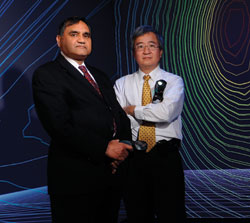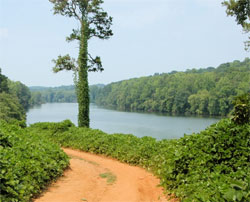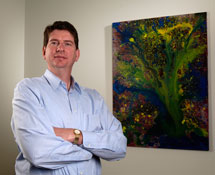UAB Engineers Push the Boundaries of 3-D Technology
By Grant Martin
 |
Bharat Soni and Alan Shih are exploring uses for UAB's 3D visualization technology in a wide range of fields, including rehabilitation, medical training, and homeland security. |
Imagine a place where amputees can learn to ski without risking serious injury; where bomb squads can disarm explosive devices with no chance of casualties; and where surgeons can make perfect incisions and perform flawless operations—before they ever touch a patient.
Researchers in the UAB School of Engineering’s Enabling Technology Laboratory have assembled just such a facility—a virtual-reality environment that can be used for a host of creative applications. This “visualization cube” is the latest expansion of the school’s computer imaging and simulation capabilities, and it could lead to revolutionary advances in a host of fields, including engineering, medicine, rehabilitation, emergency management, and education.
UAB Researcher Aims to Build a Better Gunsight
By Grant Martin
Timothy Kraft, Ph.D., is looking down the barrel of a gun. A small, black target stands 150 feet away, but Kraft isn’t focusing on the target. He’s focusing on the pistol in his hand; not the part of the gun he can see, but the part that isn’t there at all.
Kraft, an investigator in UAB’s Vision Science Research Center, is developing a new kind of gunsight that relies on a trick of the eye to improve a shooter’s aim. In this slideshow, he explains how the secret to better marksmanship may be to let the mind fill in the blanks.
By Bob Shepard
 |
Kudzu root extract could provide a novel treatment for metabolic syndrome, according to a new report from UAB researchers. |
It sure seemed like a good idea at the time. In the 1930s, farmers and government agents across the American South sowed fields with a popular new Asian import called kudzu that promised to help fight devastating erosion problems. The fast-growing plant, native to Japan and China, bloomed in the hospitable Southern climate and quickly ran wild. In 1972, it was officially declared a weed by the U.S. Department of Agriculture. Today, the “vine that ate the South” has gobbled more than 10 million acres. In the right conditions, it can grow up to a foot a day and as much as 60 feet per year—so fast, in the words of poet James Dickey, “that you must close your windows at night to keep it out of the house.”
But this much-maligned invader may contain a beneficial surprise. In findings published in August in the Journal of Agriculture and Food Chemistry, UAB researchers reported that an edible extract from kudzu’s roots may help regulate high blood pressure, cholesterol, and blood glucose—all contributors to metabolic syndrome, a condition that affects 50 million Americans and is particularly pervasive in the South.
UAB Neurobiologist Ponders the Creativity Impulse
By Charles Buchanan
 |
David Sweatt |
What kindles the spark of creativity? David Sweatt, Ph.D., finds that question doubly interesting. As neurobiology chair, director of the Evelyn F. McKnight Brain Institute at UAB, and Evelyn F. McKnight Endowed Chair for Learning and Memory in Aging, Sweatt investigates the cellular and chemical mechanisms of learning and memory. And as an abstract painter, he is curious about the possible biological basis for his vivid ideas.
In this slideshow, Sweatt shares his thoughts on the possible relationship between neurobiology and creativity.
In addition to revealing the secrets of the solar system’s past, the UVIS project being conducted by UAB physicist Perry Gerakines, Ph.D., could lead to discoveries about the system’s present—including the possibility for life.
“The mantra in NASA is ‘follow the water,’” says Gerakines. “If you’re looking for life, follow the water.” That’s one reason why Saturn’s moon Enceladus intrigues astronomers. Its surface is encased in an icy shell, but in 2005, Cassini discovered a geyser spewing water and other materials into space from Enceladus. Though the geyser doesn’t prove that the moon necessarily has liquid water, an ocean beneath the ice is an exciting possibility. Gerakines explains that a liquid ocean could exist on the frigid moon because of tidal forces; Saturn and its other moons “tug on Enceladus and squash it a little bit,” warming it sufficiently through frictional heating.
Saturn’s largest moon, Titan, has long been a mystery because its thick atmosphere completely obscures the surface. Its atmosphere is full of hydrocarbons, or “the kind of stuff we would call air pollution,” says Gerakines. While considered smog on Earth, these hydrocarbons also are organic molecules integral to many life processes. During Cassini’s initial mission, the space probe Huygens landed on Titan’s surface, finding frozen water with rivers of liquid methane and liquid ethane, used as fuels on Earth. Titan’s landscape is strikingly similar to that of the early Earth, complete with lakes, rivers, dunes, snow, clouds, and perhaps even liquid-water volcanoes. Therefore, probing Titan’s environment could provide clues about the development of our own planet.
While all of Earth’s living things require liquid water, Gerakines notes that there is more to the equation. “Life demands other things: sources of energy for metabolism, sources of fuel or food, and a way to build new structures and cells. Having water is a good hint that this might be a good place to look, but it certainly doesn’t mean that life is there.”